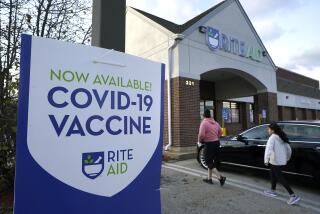UCSD Medical Center, 6 Smaller Hospitals, Form Health Alliance : Medicine: It is designed to help the hospitals remain competitive in the health-care marketplace.
UC San Diego Medical Center and six smaller hospitals announced Monday the formation of an alliance a move that creates a fourth major health care fiefdom in the county.
The new network, called the San Diego Alliance for Health Care, was formed by UCSD, Alvarado, Coronado, Harbor View, Mission Bay, Paradise Valley and Valley Medical Center.
Experts say the network will allow the seven hospitals to remain competitive in what has become a tough race in the health care marketplace, with three giants already well placed in the field: Scripps, Sharp HealthCare and Kaiser Permanente.
“The alliance is structured to preserve the consumers’ freedom to choose their health care providers, and to enhance the strength and integrity of the participating community hospitals and physicians,” said Mark C. Wells, the newly appointed chief executive officer of the San Diego Alliance for Health Care.
“At the same time,” Wells said, “the alliance greatly enables us to develop a broad range of quality managed health care programs and services with employers, insurers and the government.”
The alliance will be governed by an 11-member board that includes representatives from physician groups, hospitals and consumers. Wells, who heads the executive staff, will orchestrate marketing, contracting and planning for the alliance.
The alliance “involves hospitals and physicians who share the philosophy that we can best serve our communities by remaining independent, but who also recognize the importance of integrating activities among health care providers,” said Michael Stringer, executive director of UCSD.
“This partnership with the community is critical for UCSD Medical Center if we are to continue meeting our missions of patient care, research and teaching,” he said.
Experts say the formation of the fourth alliance was logical in a world of shrinking budgets and fierce marketplace competition.
“This places those seven hospitals and their physicians in a system to competitively respond to Sharpe, Scripps and Kaiser Permanente, which UCSD or the other hospitals alone couldn’t effectively do,” said Jim Lott, president of the Hospital Council of San Diego and Imperial counties.
For patients, the competition among several giants might prove beneficial, especially in helping prevent health care costs from skyrocketing, according to some health care officials.
“From a policy standpoint, it’s a plus for consumers,” said Charles Inlander, president of the People’s Medical Society, a Pennsylvania-based consumer group. “This kind of alliance tends to keep hospitals from fighting one another and growing bigger and bigger. . . . They aren’t going to be duplicating services.”
The buzzword dominating the health care trend is “managed care,” or providing health care in a cost-efficient setting that resembles a health maintenance organization.
Not everybody in the health care community was enthusiastic about the announcement.
Dr. G. William Cox, director of the county’s Department of Health Services, likened San Diego’s health care trend to that of the airline industry’s deregulation.
“What’s at risk here is freedom of choice and freedom of movement,” Cox said. “With deregulation of the airlines, there was a move toward absolutely monolithic giants in the industry, and the rest will fall by the wayside. I see the same trend in the health care system.”
Indeed, many experts, albeit somewhat wistfully, saw the formation of large health care networks as inevitable.
“As a physician, I don’t particularly like this. I love my freedom and independence, and I don’t want to be part of a large corporation, even if it might be a more efficient way of practicing medicine,” said Dr. Bob Reid, chairman of the county’s Access to Health Care Commission, a group whose members include representatives from local hospitals, insurance industry, employers and the Chamber of Commerce.






